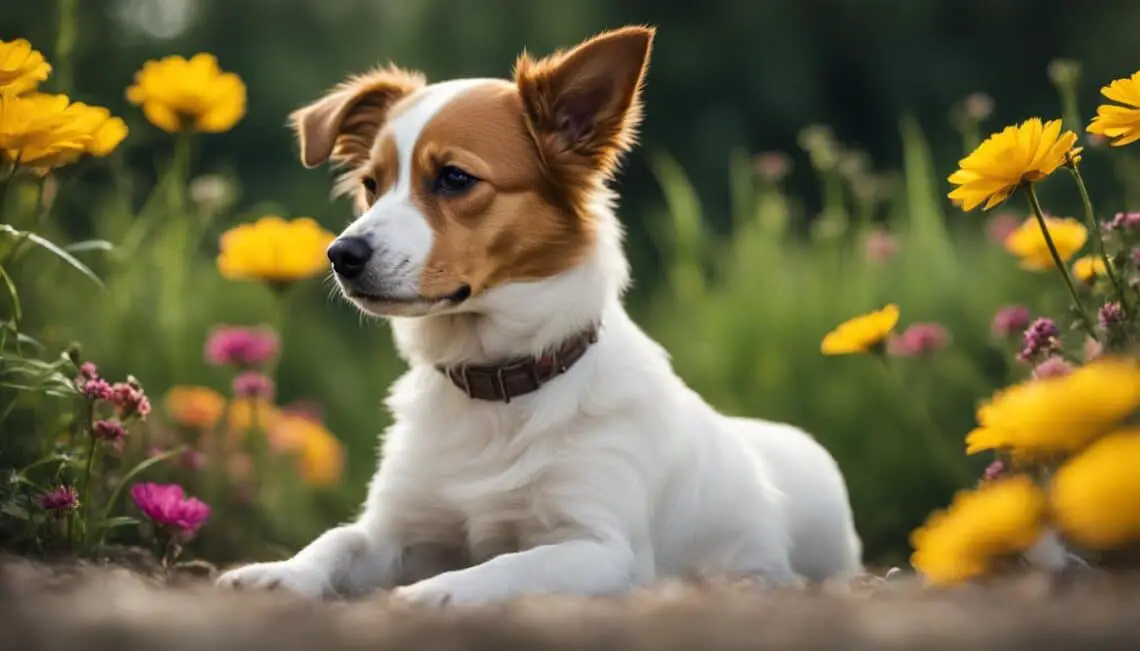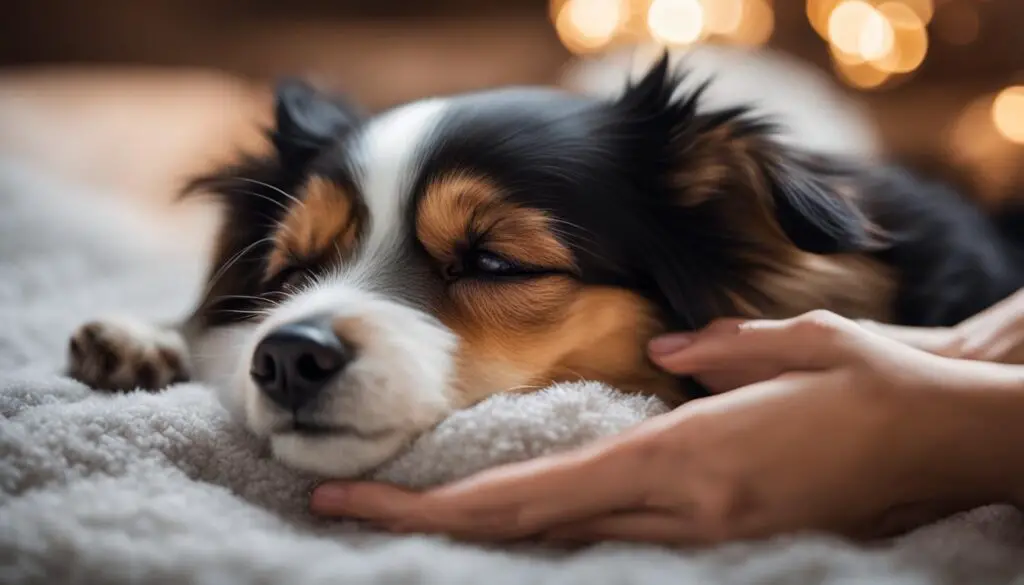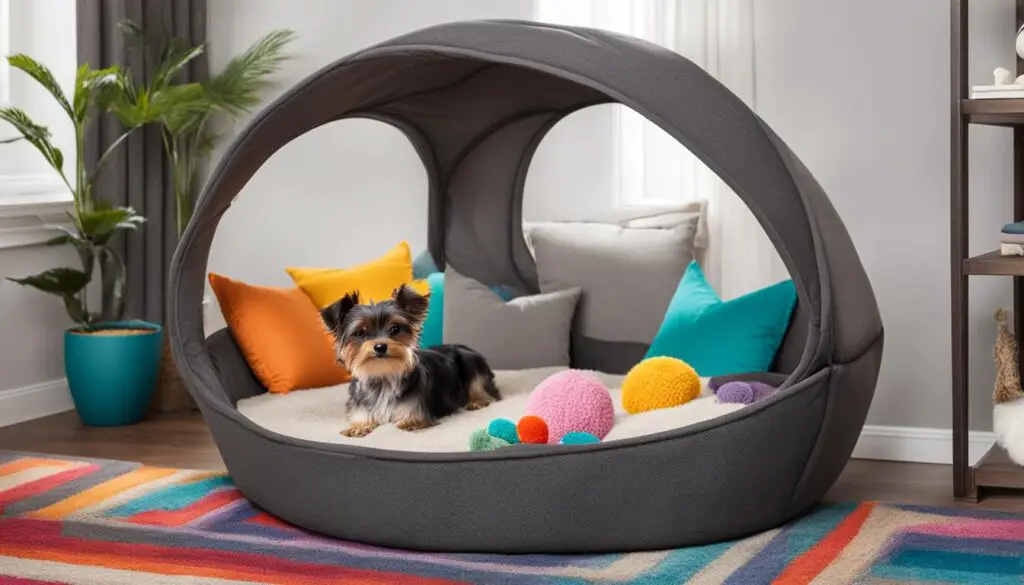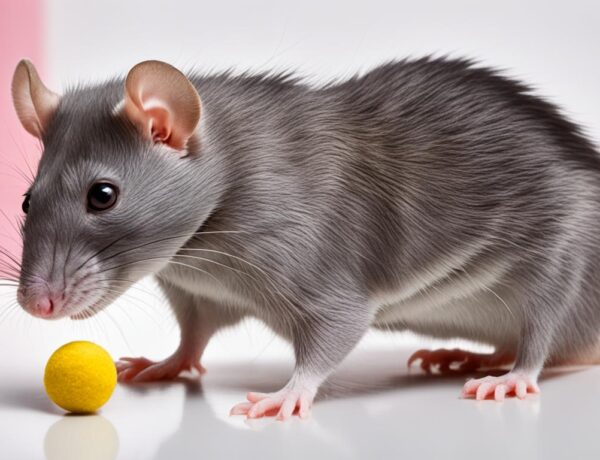Anxiety is a common issue that affects not only humans but also our furry friends, including small dogs. Just like us, small dogs can experience anxiety for various reasons, such as fear of being alone, loud noises, traveling, or unfamiliar environments. Understanding the causes and symptoms of anxiety in small dogs is crucial in effectively managing and reducing their anxiety levels.
In this article, I will share valuable tips and strategies to help calm your anxious small dog. From exercise and touch therapy to music therapy and creating a dedicated safe space, there are numerous techniques that can make a significant difference in your dog’s well-being.
Reducing anxiety in small dogs requires a holistic approach that addresses their physical and emotional needs. By implementing these proven calming strategies, you can help your canine companion lead a happier and stress-free life.
Key Takeaways:
- Small dogs can experience anxiety due to abandonment, fear of being alone, loud noises, traveling, or being around strangers.
- Regular exercise can help burn off excess energy and release endorphins that naturally alleviate stress.
- Physical contact, such as cuddling and massage therapy, can soothe anxious small dogs and promote relaxation.
- Playing calming music or classical tunes can create a relaxing environment and reduce anxiety levels.
- Creating a designated safe space for your small dog can provide them with a calm retreat when they are feeling overwhelmed.
Exercise: A Natural Way to Calm Your Anxious Small Dog
Anxiety in small dogs can be challenging to manage, but one effective strategy is to incorporate regular exercise into their routine. Exercise not only helps burn off excess energy but also promotes the release of endorphins, which are natural stress relievers. By engaging your small dog in physical activities, you can help alleviate their anxiety and promote a calmer state of mind.
There are various forms of physical activity that can benefit anxious small dogs. Taking your furry friend for daily walks is a great way to provide exercise while also allowing them to explore their surroundings. It’s an opportunity for mental stimulation and can help alleviate stress and anxiety.
Playing fetch is another engaging activity that small dogs enjoy. Not only does it provide physical exercise, but it also promotes bonding and positive reinforcement. Interactive play sessions, such as tug-of-war or hide-and-seek, can also be effective in tiring out your small dog and reducing anxiety.
During exercise sessions, it’s essential to provide plenty of physical contact and positive reinforcement. Petting, cuddling, and praising your small dog during and after exercise can help create a sense of security and strengthen the bond between you. Positive reinforcement can also help redirect their focus from anxiety-provoking stimuli to positive experiences.
Incorporating calming strategies into exercise sessions can further enhance their effectiveness. For example, you can play calming music to create a relaxing atmosphere during walks or interactive play. Certain types of music, such as classical music or nature sounds, have been shown to have a soothing effect on dogs.
Additionally, consider utilizing calming coats or wraps designed specifically for anxious dogs. These products apply gentle pressure to the torso, similar to the sensation of being swaddled, which promotes a sense of security and comfort.
Benefits of Exercise for Anxious Small Dogs:
- Reduces stress and anxiety levels
- Burns off excess energy
- Promotes the release of endorphins
- Enhances bonding and positive reinforcement
- Creates a sense of security and comfort
Integrating regular exercise into your anxious small dog’s routine can have a significant positive impact on their well-being. Not only does exercise provide physical and mental stimulation, but it also promotes overall relaxation and a calmer state of mind.
Remember to consult with your veterinarian to ensure that the exercise routine you design is suitable for your small dog’s individual capabilities and health needs.
| Exercise Activity | Description |
|---|---|
| Walks | Take your small dog for daily walks to provide physical exercise and mental stimulation. |
| Fetch | Engage in a game of fetch to promote physical activity and bonding. |
| Interactive Play | Play games such as tug-of-war or hide-and-seek to tire out your small dog and reduce anxiety levels. |
| Calming Music | Play calming music during exercise sessions to create a relaxing atmosphere. |
| Calming Coats or Wraps | Utilize specially designed coats or wraps that provide gentle pressure to promote a sense of security and comfort. |
Touch Therapy: The Power of Physical Contact for Anxious Small Dogs
Anxiety can be a challenging issue for small dogs, causing them distress and discomfort. One effective approach to reducing anxiety in these furry friends is through touch therapy. Physical contact, such as cuddling, petting, or holding, can have a calming effect on anxious small dogs.
When a small dog experiences physical contact, it helps them feel secure and loved, alleviating their anxiety levels. The power of touch is undeniable, as it creates a sense of comfort and connection between dogs and their owners. This physical bond can serve as a powerful tool in soothing an anxious small dog.
“Physical contact creates a sense of comfort and connection between dogs and their owners.”
In addition to general touch therapy, massage therapy can be especially beneficial for small dogs with anxiety. Just like humans, dogs can hold tension and stress in their muscles. Gentle massaging helps release this tension, promoting relaxation and reducing anxiety levels.
When giving a massage to an anxious small dog, start with gentle strokes on the neck and gradually work your way down their body. Pay attention to their response, focusing on areas where you feel tension or tightness. The rhythmic and deliberate motion of the massage can be comforting to both you and your small dog.
The Benefits of Touch Therapy for Small Dogs:
- Reduces anxiety levels
- Creates a sense of security and comfort
- Promotes bonding between dog and owner
- Helps release muscle tension and promotes relaxation
When practicing touch therapy with your anxious small dog, it’s important to approach them gently and calmly. Pay attention to their body language and respond accordingly. Some small dogs may not immediately feel comfortable with touch therapy, so it’s essential to be patient and give them time to adjust.
| Techniques for Touch Therapy: | Description: |
|---|---|
| Cuddling | Holding your small dog close to your body in a comforting embrace. |
| Petting | Gently stroking your small dog’s fur in a soothing manner, paying attention to their preferences. |
| Massaging | Applying gentle pressure and rhythmic strokes to release muscle tension and promote relaxation. |
By incorporating touch therapy, such as cuddling, petting, and massage, into your daily routine, you can provide relief and comfort to your anxious small dog. Remember, every dog is unique, so it’s important to observe their individual responses and adjust your approach accordingly. When done correctly and with love, touch therapy can be a powerful tool in helping your small dog overcome anxiety and live a happier, calmer life.
Music Therapy: How Music Can Calm Your Anxious Small Dog
Music therapy has proven to be an effective method for reducing anxiety in both humans and animals, including dogs. By playing soothing music or classical tunes, you can create a calming environment for your anxious small dog. Research indicates that specific types of music, such as harp music or classical compositions, can have a sedative effect on dogs, helping to block out external noises and create a relaxing atmosphere that alleviates their anxiety levels.
Harnessing the power of music can significantly contribute to your small dog’s anxiety relief and overall well-being. Just as humans find comfort and relaxation in certain genres or melodies, dogs can also benefit from the calming effects of music therapy.
The Benefits of Music Therapy for small dogs
When carefully selected, music has the ability to positively impact a dog’s emotional state, promoting relaxation and reducing anxiety. Here are some key benefits of utilizing music therapy for your anxious small dog:
- Stress reduction: Calming music can help reduce stress and anxiety levels, creating a sense of tranquility for your small dog.
- Soothing sleep: Playing gentle tunes before bedtime can aid in inducing a restful sleep for your dog, allowing them to wake up feeling refreshed.
- Reduction of separation anxiety: Music can help alleviate the distress some small dogs experience when left alone, providing them with a comforting presence.
- Distraction from triggers: By playing calming music, you can distract your small dog from triggering sounds or events that may normally increase their anxiety levels.
Choosing the Right Music for Your Anxious Small Dog
When it comes to selecting music for your small dog’s anxiety relief, it is essential to consider their individual preferences and needs. Here are some guidelines to help you choose the right music:
- Calming melodies: Opt for slow-tempo music with gentle melodies, as these are more likely to induce relaxation in your small dog.
- Classical compositions: Classical music has been shown to have a particularly calming effect on dogs. Experiment with different classical pieces to find what works best for your furry friend.
- Nature sounds: Some small dogs find comfort in the soothing sounds of nature, such as rainfall, birdsong, or ocean waves. Consider incorporating nature-inspired sounds into your dog’s music playlist.
“Music has a profound effect on our emotions and can elicit deep feelings of relaxation and peace. This same effect can be harnessed to create a therapeutic experience for anxious small dogs, helping them find solace in the melodies that surround them.”
Creating a Calming Music Playlist for Your Small Dog
To maximize the benefits of music therapy, create a dedicated playlist tailored to your small dog’s needs. Consider the following:
- Length of time: The playlist should be long enough to provide continuous relief for your small dog, especially during extended periods of anxiety-triggering situations.
- Repetition: Small dogs often find comfort in familiar sounds and melodies. Including a few core songs or compositions that can be repeated can offer a source of consistency and relaxation.
- Transition cues: Using specific songs or sounds as cues for transitioning from stressful situations to relaxation can help condition your small dog to associate music with calmness.
Remember, every small dog is unique, so observing their reactions and adjusting the music playlist accordingly can help create the most effective and personalized music therapy experience.
| Benefits of Music Therapy for Small Dogs | Guidelines for Choosing Music | Tips for Creating a Calming Music Playlist |
|---|---|---|
| Stress reduction | Calming melodies | Length of time |
| Soothing sleep | Classical compositions | Repetition |
| Reduction of separation anxiety | Nature sounds | Transition cues |
| Distraction from triggers |
Time-Out: Creating a Calm Retreat for Your Anxious Small Dog
Creating a designated safe space for your anxious small dog can provide them with a calm retreat when they are feeling overwhelmed. This space should be quiet, comfortable, and free from distractions. It can include elements such as low lighting, soft music, or even aromatherapy. Providing a ZenCrate, which is a specialized crate designed to provide comfort and security, can also be beneficial for time-outs. Allowing your small dog to have a dedicated space where they can relax and feel safe can help reduce their anxiety.
“Having a safe and quiet space for my anxious Chihuahua has made a tremendous difference in managing her anxiety. I created a cozy corner in my living room with soft blankets, a calming lavender diffuser, and soothing classical music playing in the background. Whenever she starts to feel anxious, she seeks out her designated space and finds comfort and relief.”
Providing a time-out space for your anxious small dog is essential to their overall well-being. This designated area allows them to retreat, unwind, and recharge, helping to alleviate their anxiety. Here are some key elements to consider when creating a safe space for your small dog:
- Choose a quiet area: Find a location in your home where your small dog will experience minimal noise and commotion. This could be a spare bedroom, a quiet corner of your living room, or even a secluded area in your backyard.
- Create a cozy environment: Make the space comfortable and inviting for your small dog. Include soft blankets or bedding for them to snuggle up on, ensuring they feel warm and secure.
- Control the lighting: Low lighting or diffused natural light can help create a calming ambiance in the time-out space. Avoid bright or fluorescent lighting that may cause added stress or anxiety.
- Add soothing sounds: Playing soft, calming music or nature sounds can help drown out external noises and create a peaceful atmosphere for your small dog.
- Consider aromatherapy: Certain scents, such as lavender or chamomile, have relaxing properties. Use a pet-safe diffuser or spray to infuse the time-out space with these soothing aromas.
Providing a ZenCrate for Time-Outs
A ZenCrate is a specialized crate designed specifically for providing comfort and security to anxious dogs. This innovative crate incorporates features such as sound insulation, vibration-dampening technology, and a calming music system to create a tranquil space for your small dog. The ZenCrate also has a motion-activated fan to provide ventilation and fresh air. With its cozy interior and calming features, a ZenCrate can serve as the perfect time-out space for your anxious small dog.
Testimonial: Finding Peace in the ZenCrate
“My Yorkshire Terrier suffers from separation anxiety, and we struggled to find a solution that would help him feel safe and calm when we were away. The ZenCrate has been a game-changer for us. He willingly goes into the crate during his time-outs, and the built-in music and motion-activated fan help soothe his anxiety. I highly recommend it to any pet parent dealing with an anxious small dog.”
Creating a designated time-out space for your anxious small dog is one of the many strategies you can employ to help alleviate their anxiety. By providing them with a calm retreat and implementing elements such as quietness, comfort, and soothing ambiance, you can create an environment that promotes relaxation and reduces stress. Remember, every small dog is unique, so it may take some trial and error to discover what works best for your furry friend. Observing their behavior and adjusting the time-out space accordingly will help ensure their anxiety relief and overall well-being.
Calming Coats and Alternative Therapies for Anxious Small Dogs
When it comes to reducing anxiety in small dogs, there are various options available to provide them with comfort and relief. Two popular choices are calming coats and alternative therapies. Calming coats, such as the ThunderShirt Anxiety Jacket or the American Kennel Club Stress Relief Coat, apply gentle pressure to a small dog’s torso, similar to a swaddling cloth for a baby. This pressure provides comfort and can significantly help reduce anxiety in small dogs.
Alternative therapies can also be effective in alleviating anxiety in small dogs naturally. One popular option is Rescue Remedy for Pets, a natural stress relief formula that can help soothe anxious pets. It contains a blend of flower essences that are known for their calming properties. Another alternative therapy is the use of supplements containing melatonin or chamomile. Melatonin is a hormone that helps regulate sleep, while chamomile has calming and relaxation effects.
Before trying alternative therapies, it is essential to do thorough research and consult with a veterinarian. They can provide guidance and ensure that the chosen alternative therapy is safe and suitable for your small dog. Every dog is unique, and what works for one may not work for another. Therefore, it is crucial to consider your small dog’s specific needs and consult with a professional for personalized advice.
Comparison of Different Calming Coats for Small Dogs
| Brand | Description | Price Range |
|---|---|---|
| ThunderShirt Anxiety Jacket | A lightweight and snug-fitting jacket that provides constant pressure to help calm anxious dogs. Available in various sizes and colors. | $39.95 – $44.95 |
| American Kennel Club Stress Relief Coat | A soft and comfortable coat that offers gentle pressure to help relieve anxiety in dogs. Features adjustable straps and is machine washable. | $29.99 – $39.99 |
“Calming coats can be a fantastic tool for reducing anxiety in small dogs. The gentle pressure they provide mimics the feeling of being swaddled, which can create a sense of security and help calm anxious dogs.” – Dr. Lisa Johnson, Veterinarian
In conclusion, calming coats and alternative therapies offer effective ways to alleviate anxiety in small dogs. Calming coats apply gentle pressure to provide comfort, while alternative therapies such as Rescue Remedy for Pets and supplements containing melatonin or chamomile can naturally soothe anxious dogs. It is essential to research, consult with a veterinarian, and consider your small dog’s individual needs when using these methods. By exploring these options, you can help your anxious small dog find relief and enjoy a calmer and happier life.
Conclusion: Empowering Your Anxious Small Dog with Calming Strategies
Managing and reducing anxiety in small dogs can be an ongoing challenge. However, with the right strategies and techniques, you can empower your furry friend to lead a calmer and happier life. By understanding the causes and symptoms of anxiety, you can better address their specific needs and provide effective solutions.
Exercise plays a crucial role in reducing anxiety in small dogs. Regular physical activity helps burn off excess energy and promotes the release of stress-relieving endorphins. Whether it’s going for daily walks, engaging in interactive play, or playing fetch, incorporating exercise into their routine can make a significant difference in their anxiety levels.
In addition to physical activity, the power of touch should not be underestimated. Cuddling, petting, and gentle massages can all provide comfort and security to an anxious small dog. These acts of physical contact can help alleviate tension and release anxiety-related muscle stiffness, promoting relaxation.
Music therapy is another effective tool for calming small dogs. Soft, soothing music can create a serene environment, providing a sense of tranquility and blocking out external noises that may trigger anxiety. You can experiment with different genres, such as classical or harp music, to find what works best for your furry companion.
To create a safe space for your anxious small dog, designate a quiet and comfortable area where they can retreat when feeling overwhelmed. This space should be free from distractions, with features like low lighting, soft music, or aromatherapy to promote relaxation. Consider investing in a specialized crate like the ThunderShirt Anxiety Jacket or the American Kennel Club Stress Relief Coat, which apply gentle pressure to the torso, providing a calming effect.
While these strategies can be helpful, remember to consult with a veterinarian for personalized guidance. They can provide additional treatment options and ensure the safety and suitability of any alternative therapies you wish to explore. By combining these calming strategies tailored to your small dog’s individual needs, you can help reduce their anxiety and create a harmonious environment for both of you.
FAQ
Why do small dogs experience anxiety?
Small dogs can experience anxiety due to reasons such as abandonment, fear of being alone, loud noises, traveling, or being around strangers.
How can exercise help relieve anxiety in small dogs?
Regular physical activity can help burn off excess energy and produce endorphins, which are natural stress relievers. Taking your small dog for walks, playing fetch, or engaging in interactive play can help tire them out and alleviate their anxiety.
How does physical contact benefit anxious small dogs?
Physical contact, such as cuddling, petting, or holding, can be extremely soothing for anxious small dogs. It helps them feel secure and loved, reducing their anxiety levels. Massage therapy can also be beneficial for small dogs with anxiety as it helps release tension and promotes relaxation.
Can music therapy help calm anxious small dogs?
Yes, playing soothing music or classical tunes can create a calming environment for your anxious small dog. Certain types of music, such as harp music or classical music, have a sedative effect on dogs and can help block out external noises, reducing their anxiety levels.
How can I create a safe space for my anxious small dog?
Creating a designated safe space for your anxious small dog can provide them with a calm retreat when they are feeling overwhelmed. This space should be quiet, comfortable, and free from distractions. It can include elements such as low lighting, soft music, or even aromatherapy. Providing a ZenCrate, which is a specialized crate designed to provide comfort and security, can also be beneficial for time-outs.
Are there any products or therapies that can help alleviate anxiety in small dogs?
Yes, calming coats such as ThunderShirt Anxiety Jacket or American Kennel Club Stress Relief Coat can provide gentle pressure to a small dog’s torso, helping reduce anxiety. Additionally, alternative therapies such as Rescue Remedy for Pets or supplements containing melatonin or chamomile can be used to naturally alleviate anxiety in small dogs. It is important to research and consult with a veterinarian before trying alternative therapies.
How can I effectively manage and reduce anxiety in my small dog?
Managing and reducing anxiety in small dogs requires a combination of strategies tailored to their individual needs. By understanding the causes and symptoms of anxiety, providing exercise and physical contact, using music therapy, creating a safe space, and exploring alternative therapies, you can help alleviate your small dog’s anxiety and promote a happier, healthier life for them. Always consult with a veterinarian for personalized guidance and to explore any additional treatment options that may be necessary for your small dog’s specific situation.







No Comments